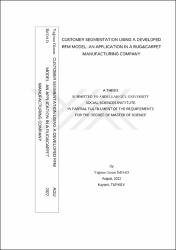| dc.contributor.author | İmdad, Yağmur Gizem | |
| dc.date.accessioned | 2023-05-25T14:00:52Z | |
| dc.date.available | 2023-05-25T14:00:52Z | |
| dc.date.issued | 2022 | en_US |
| dc.date.submitted | 2022-08-23 | |
| dc.identifier.uri | https://hdl.handle.net/20.500.12573/1600 | |
| dc.description.abstract | Data science has gained enormous importance by contributing to the in-depth understanding and interpretation of information. Especially companies consult on data analysis to make strategic decisions in the competitive market. Much more important than the decisions taken is a determination of the customer or customer groups to which these decisions will be adapted. For that reason, customer segmentation by identifying similarities and differences between customers becomes crucial. In recent times, the RFM model is preferred mostly for customer segmentation. The RFM model is based on the customer's last purchase date, how often they purchase, and how much money contributes to the company. It is an easy model to understand and interpret results in a clear way. Many researchers prefer to apply the RFM method by adding extra variables to the analysis. Thus, customers are evaluated from a broader perspective. This study aims to present a developed RFM model by adding extra variables which are Loyalty, Dependence, and Expectation which are determined by a broad literature review and as a result of a survey relating to 106 dealers. There are some studies that create a segmentation model by using loyalty and the RFM model. However, this study developed a new model by including the dependence and expectation variables, which are not been used previously with the RFM model, besides loyalty. In the study, dealers are analyzed by the K-means clustering method and the optimum number of clusters is indicated as six. Each cluster has its specific customer behavior and this study guides the company to constitute marketing strategies regarding customers' specifications. | en_US |
| dc.description.abstract | Veri bilimi, bilginin derinlemesine anlaşılmasına ve yorumlanmasına katkıda bulunarak büyük önem kazanmıştır. Özellikle şirketler, rekabetçi pazarda stratejik kararlar almak için veri analizine başvurmaktadır. Alınan kararlardan çok daha önemli olan, bu kararların hangi müşteri ya da müşteri gruplarına uyarlanacağının belirlenmesidir. Bu nedenle müşteriler arasındaki benzerlikleri ve farklılıkları belirleyerek müşteri segmentasyonu yapmak çok önemli hale geliyor. Son zamanlarda müşteri segmentasyonu için RFM modeli çoğunlukla tercih edilmektedir. RFM modeli, müşterinin son satın alma tarihine, ne sıklıkla satın aldığına ve şirkete ne kadar para kazandırdığına dayanmaktadır. Sonuçları net bir şekilde anlamak ve yorumlamak için kolay bir modeldir. Birçok araştırmacı analize ekstra değişkenler ekleyerek RFM yöntemini uygulamayı tercih etmektedir. Böylece müşteriler daha geniş bir perspektiften değerlendirilir. Bu çalışma, geniş bir literatür taraması ve 106 bayiye ait anket sonucunda belirlenen Sadakat, Bağımlılık ve Beklenti değişkenleri eklenerek geliştirilmiş bir RFM modeli sunmayı amaçlamaktadır. Sadakat ve RFM modelini kullanarak segmentasyon modeli oluşturan bazı çalışmalar bulunmaktadır. Ancak bu çalışma, sadakatin yanı sıra RFM modeli ile daha önce kullanılmayan bağımlılık ve beklenti değişkenlerini de dahil ederek yeni bir model geliştirmiştir. Çalışmada, bayiler K-ortalama kümeleme yöntemi ile analiz edilmiş ve optimum küme sayısı altı olarak belirtilmiştir. Her kümenin kendine özgü müşteri davranışı vardır ve bu çalışma şirkete, müşterilerin özelliklerine göre pazarlama stratejileri oluşturma konusunda rehberlik eder. | en_US |
| dc.language.iso | eng | en_US |
| dc.publisher | Abdullah Gül Üniversitesi, Sosyal Bilimleri Enstitüsü | en_US |
| dc.rights | info:eu-repo/semantics/openAccess | en_US |
| dc.subject | Data Science | en_US |
| dc.subject | Customer Segmentation | en_US |
| dc.subject | RFM | en_US |
| dc.subject | K-Ortalamalı Kümeleme | en_US |
| dc.subject | Veri Bilimi | en_US |
| dc.subject | Müşteri Segmentasyonu | en_US |
| dc.subject | K-Means Clustering | en_US |
| dc.title | Customer segmentation using a developed RFM model: An application in a rug&carpet manufacturing company | en_US |
| dc.title.alternative | Geliştirilmiş RFM modeli ile müşteri segmentasyonu: bir halı ve kilim üretici firmasında uygulama | en_US |
| dc.type | masterThesis | en_US |
| dc.contributor.department | AGÜ, Sosyal Bilimler Enstitüsü, Veri Bilimi Anabilim Dalı | en_US |
| dc.relation.publicationcategory | Tez | en_US |


















